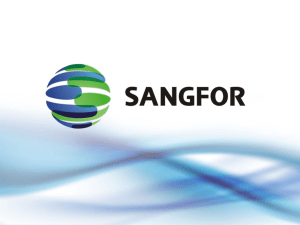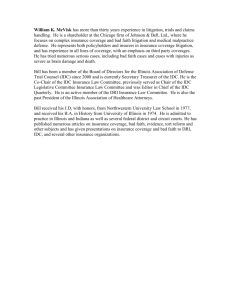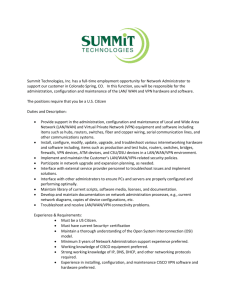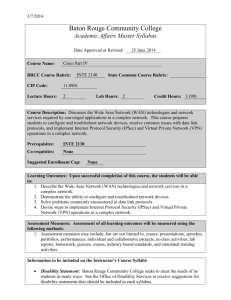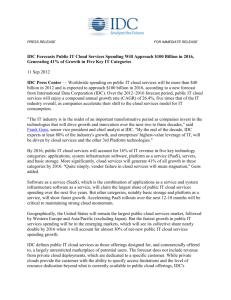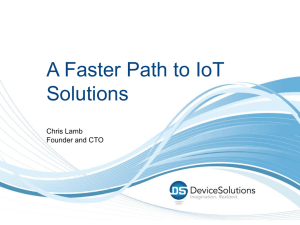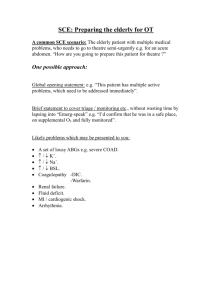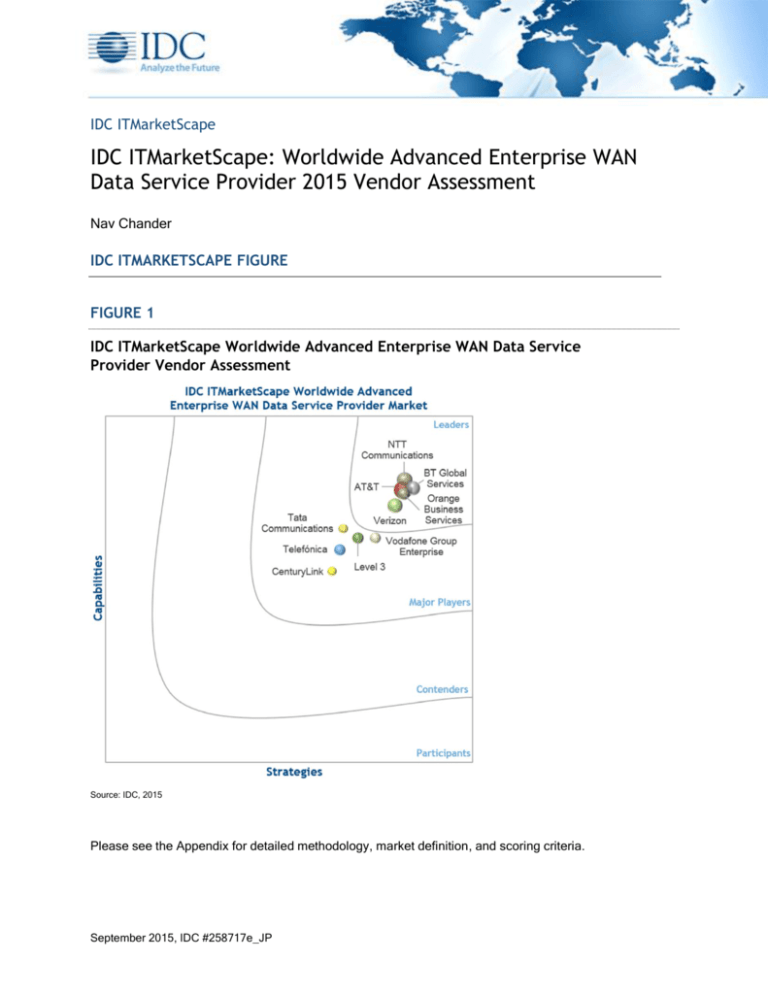
IDC ITMarketScape
IDC ITMarketScape: Worldwide Advanced Enterprise WAN
Data Service Provider 2015 Vendor Assessment
Nav Chander
IDC ITMARKETSCAPE FIGURE
FIGURE 1
IDC ITMarketScape Worldwide Advanced Enterprise WAN Data Service
Provider Vendor Assessment
Source: IDC, 2015
Please see the Appendix for detailed methodology, market definition, and scoring criteria.
September 2015, IDC #258717e_JP
IN THIS EXCERPT
The content for this excerpt was taken directly from IDC ITMarketScape: Worldwide Advanced
Enterprise WAN Data Service Provider 2015 Vendor Assessment (Doc #259717). All or parts of the
following sections are included in this excerpt: IDC Opinion, IDC ITMarketScape Vendor Inclusion
Criteria, Essential Guidance, Vendor Summary Profile, Appendix and Learn More. Also included is
Figure 1.
IDC OPINION
This study leverages the IDC ITMarketScape methodology to evaluate the leading global
telecommunications service providers (SPs) that offer advanced enterprise WAN data services. IDC
identified the top 10 service providers by scale and scope of operations, primarily their global coverage
and the ability to provide services to global multinational corporations (MNCs). One major qualification
was the presence of at least 30% of employees located outside the global service provider's (GSP's)
home country as well as the ability to provide innovative and forward-thinking solutions incorporating
the latest developments in open source platforms, network virtualization, NFV, software-defined
networking (SDN), and cloud connectivity network technologies into their WAN solutions. The primary
focus of this study is the portfolio of global telecom service providers that cater to multinational
companies. This requires the ability to provide global network coverage in major metro markets and
also cover the following areas:
Existing advanced enterprise WAN data services, such as MPLS and hybrid VPNs, Carrier
Ethernet services, Ethernet access, and secure IP network services, provided on a consistent
basis worldwide and backed by a qualified core of supporting personnel
Strong focus on emerging advanced WAN data services like datacenter interconnect (DCI)
services that provide enterprises with high-capacity, low-latency optical, Ethernet, and routing
options to a diverse range of secure service provider or third-party partner datacenter facilities
with network connection options in regional and global datacenters or colocation facilities
The capability to offer enterprises new cloud connect services that extend enterprise MPLS/IP
VPN or Ethernet services to include secure access to public and private cloud services
including SaaS providers
Strong global partnerships via enhanced network-to-network interconnects (NNIs) and channel
partners to provide access to countries where the service provider does not have own network
facilities
IDC ITMARKETSCAPE VENDOR INCLUSION CRITERIA
This is the first IDC ITMarketScape that focuses on the burgeoning area of enterprise WAN data
communication services that also includes the emerging role of innovative software-defined WAN
services and NFV technology. Key criteria include the ability to provide a comprehensive global
portfolio of services ranging from IP VPN and Ethernet WAN data networking services to DCI and
enterprise WAN cloud connect services and emerging NFV-based virtualization WAN services that will
be offered on demand.
These service providers must have, at minimum, enhanced global capabilities to offer the following:
Managed WAN data services (IP VPN, MPLS VPN, security, managed CPE, hosting)
©2015 IDC
#258717e_JP
2
Diverse set of Ethernet WAN services (VPLS, EPL, EVPL, E-LAN, and E-Access)
Enterprise VPN/Ethernet cloud connect services to connect to IaaS, PaaS, or SaaS
Range of DCI WAN services (Layer 3 VPN, Ethernet, optical)
Consulting, design, and professional services
Partner and third-party communication service provider (CSP) and NNI strategy to support
hybrid WAN deployments
A global organizational sales and support structure was also a key element in the inclusion process.
Another key criterion was the ability of worldwide telecom service providers to implement a centralized
global account and support management team to offer a consistent global experience.
ESSENTIAL BUYER GUIDANCE
Global telecom service providers have made some significant investments in migrating their network
infrastructure to support more IP- and Ethernet-based enterprise WAN services during the past two
years and also expand their worldwide capabilities. This includes responding to the increasing
enterprise demand for extending enterprise WAN services to provide secure connectivity services to
public and private cloud services as well. While no one carrier aspires to be the sole enterprise WAN
provider, most can certainly provide reasonably excellent regional coverage — and worldwide coverage
with enhanced partnership NNIs that have become the norm.
Many service providers today are offering very similar enterprise WAN service offerings such as
Ethernet, MPLS VPN, and datacenter interconnect: Most have responded to enterprise requirements
for consistent, cost-effective worldwide coverage and have built their own network infrastructure in
major metro markets with managed VPN and Ethernet access coverage or developed partnerships
with other service providers. They diverge on focus and key strategic capabilities. Some companies
like AT&T and NTT Communications (NTT Com) are very focused on following and meeting the A to B
end needs of MNCs in their home market. Others like BT, Orange, Telefónica, and Verizon have
become strong players in other regions as well — BT in Asia/Pacific, Orange in the Middle East and
Africa (MEA), Telefónica in Latin America, and Verizon in Western Europe. Smaller players like Level
3, Vodafone Group Enterprise (VGE), and Tata Communications can provide strong enterprise WAN
coverage in a surprisingly large number of geographical locations.
Selecting a global provider will largely depend on key enterprise requirements:
Global coverage: All of the operators in the Leaders quadrant provide excellent global
coverage. Orange Business Services, BT, and Vodafone lead in terms of the most local
country presence, but BT, Verizon, NTT, and AT&T will provide adequate coverage via
enhanced NNIs.
MPLS and IP VPN services: Enterprises will continue to employ IP and MPLS VPN services
but are looking at more flexible alternatives in terms of mobile remote access, hybrid InternetMPLS VPN solutions, cloud connect extensions, and a new set of cloud-based VPN service
alternatives to complement their existing VPN solutions that extend VPN capabilities and SLAs
to all sites and devices. All of the communication service providers in this study have
developed a strong portfolio of MPLS VPN solutions with tiered service offerings and network
SLAs. Orange Business, BT, Verizon, and AT&T have the most comprehensive portfolio
among Leaders and have enhanced offerings to include hybrid offers, but Major Players such
as Level 3, Tata, and Vodafone have augmented their global MPLS VPN capabilities and
©2015 IDC
#258717e_JP
3
infrastructure in the past two years by focusing on hybrid WAN applications and improved
global coverage and are likely to attract interest from MNCs.
Cloud connect and DCI services: There is growing enterprise demand and interest for DCI and
cloud connect services as enterprises increasingly migrate applications to cloud-based
solutions and use of flexible datacenters. Enterprise investments in hybrid cloud and
networking are key focus areas for this year. These have also become areas of acute
investment by most of the CSPs; NTT, Level 3, AT&T, and Orange are leading the way with
the most diverse cloud connect and DCI services, and others such as Vodafone, BT, and
Verizon are providing strong DCI capabilities and dynamic cloud connect capabilities including
hybrid and integrated access to managed/cloud VPN platforms.
Ethernet services: Global enterprise demand for Ethernet services continues to grow as more
enterprises transport larger bandwidth and increase use of DCI, storage, and other highbandwidth applications. The primary drivers for growth are large migrations from TDM to
Ethernet services, robust demand for higher-speed Ethernet private lines, and rising
requirements for connectivity to public and private clouds. All of the CSPs in this study have
made significant investments in the past two years to upgrade their network infrastructure, add
locations, increase NNIs, and migrate their legacy data services and access networks to
Ethernet and IP. Orange, AT&T, Level 3, and Verizon are leading the way with the most
innovative offerings for their Ethernet service portfolio offering dynamic bandwidth, on-demand
options, self-service bandwidth provisioning and hybrid VPN support for Ethernet, and the
most on-net Ethernet services in their respective markets.
VENDOR SUMMARY PROFILES
This section briefly explains IDC's key observations resulting in a vendor's position in the IDC
ITMarketScape. While every vendor is evaluated against each of the criteria outlined in the Appendix,
the description here provides a summary of each vendor's strengths and challenges.
AT&T
AT&T is positioned as a Leader in the 2015 worldwide advanced enterprise WAN data service provider
IDC ITMarketScape.
AT&T is undergoing a significant network and organizational transformation as part of its Domain 2.0
strategy announced in early 2014, which addresses the shift to a digital economy. The company's
strategic investments in network virtualization and software-defined networking technology is expected
to transform 75% of the network to a software-centric infrastructure by 2020 and will support AT&T's
User-Defined Network Cloud offerings. The network strategy transformation has a significant focus on
the enterprise WAN data services, and the company has already announced its Network on Demand
service strategy starting with the introduction of on-demand Ethernet services in late 2014.
AT&T targets the top 1,700 MNCs on a global basis and remains a leader in the provision of "strategic
services" to top MNCs worldwide. The company extended its leadership role with a robust portfolio of
enterprise managed services, MPLS VPN, WAN, DCI, and cloud connect services, and it is
aggressively seeking new innovations to improve the customer experience with the introduction of a
new on-demand service portfolio.
©2015 IDC
#258717e_JP
4
Strengths
AT&T has a global multilayer (MPLS/IP/Ethernet) network that spans the Americas, EMEA, and
Asia/Pacific regions, with direct fiber/Ethernet access in over 50 countries. AT&T has a great track
record in driving growth of the key enterprise WAN services required by MNCs. These include
managed services, MPLS and Layer 3 IP services, hosting, and cloud connect and cloud services.
The company is one of the global leaders in MPLS and VPN remote access solutions, including mobile
enterprise VPN solutions, and since 2013, with the introduction of the NetBond service, AT&T is one of
the first CSPs to provide an end-to-end global MPLS VPN cloud connectivity solution with major public
cloud service providers. AT&T is also one of the first service providers to implement new innovative
virtualized WAN services with its network on-demand strategy, part of a multiyear network
transformation goal. It followed up in April 2015 with a general rollout of Ethernet service to 100 U.S.
metro markets. AT&T designed, developed, and implemented the most significant new telecom service
architecture based on SDN principles, programmable network elements, and a DevOps software
environment in less than 18 months. AT&T is reducing service provisioning cycle time and reducing its
capex on WAN network infrastructure by employing more open source and programmable software
network elements, which will enable more integration with other third-party providers and partners.
Challenges
AT&T has made a strategic decision to embrace a new, agile IT-oriented development model, and it is
pivoting to reflect the emerging cloud and virtualized service delivery and consumption model. It,
however, still recognizes that the global requirements of its MNC customers will require partnerships
and has implemented numerous NNI partnerships in major regions. It remains to be seen how the new
on-demand Ethernet services will be offered to MNC customers end to end in this multi–service
provider environment.
For AT&T, the larger challenges remain its large-scale organizational and cultural transformation to the
DevOps environment and rapid service development. For AT&T, like other CSPs, the challenge will be
its ability to successfully transform into the communications platform of the future, including
modernizing its workforce, and processes, while staving off fierce competition from multiple sectors
and emerging models.
BT Global Services
BT Global Services is positioned as a Leader in the 2015 advanced enterprise WAN data service
provider IDC ITMarketScape.
BT Global Services is one of the leading providers of global enterprise WAN services and cloud
connectivity services. BT has been aggressive in its transformation to a converged information and
communication technology (ICT) solution provider with the injection of IT practices into its processes
as it evolves to meet enterprise requirements for converged ICT solutions and positions its "intelligent
hybrid network." BT Global Services is one of the first CSPs to implement a global MPLS network
services platform that delivers the same Ethernet (Ethernet connect), MPLS/IP VPN (IP connect), and
Internet services (Internet connect) to all MNC enterprise customers from the same network. The
company has made great strides in automating global service delivery and support mechanisms, and it
has established a strong presence beyond its home market to the Asia/Pacific and Americas regions
plus integrated one the strongest NNI WAN partner network. The company has also tightened its focus
and established a disciplined bidding process, which over the past 18 months has facilitated a steady
earnings growth trend.
©2015 IDC
#258717e_JP
5
Strengths
BT Global Services has a well-segmented portfolio that addresses MNC requirements for WAN
network services: BT Connect, the company's network and application performance management
services; BT One, the collaboration cloud and IT adjacent services; and BT Compute, datacenter and
cloud services. BT Connect's cloud networking solution strategy is well defined. The company is
integrating all the services available to its customer through its Cloud of Cloud Vision such as BT
Cloud Compute, BT Contact, and BT One. All those services are on net to BT's IP Connect global
network, but also through the consolidation of all services under the same virtualization platform and
the creation of a consistent framework to create end-to-end service wrap adapted to each services and
encompassing BT's VPN offer.
BT's Cloud of Cloud Vision strategy is being implemented at a rapid pace with 20 cloud-enabled
datacenter facilities across five continents and a further 30 datacenters from third-party cloud service
providers connected to their network including Cisco, Equinix, Interxion, Microsoft Azure, HP Helion,
and direct connections to key cloud service providers including ExpressRoute, Amazon Web Service,
and SalesForce.
BT Global Services was also one of the first CSPs to offer an extensive portfolio of optical, Ethernet,
and IP Connect DCI services in over 50 countries at BT-owned and third-party datacenters. This
portfolio is supported globally by BT Advise, BT Global Services' professional services team. BT has
always stressed innovation and technology leadership. It was one of the early leaders in managed
services, and it has evolved as a leader in the cloud connect space with the integration of Internet
Web-based VPNs and IP Connect global VPN services to connect to third-party cloud SaaS and IaaS
services.
BT Global Services is a leader in leveraging emerging SDN and NFV technology platforms to
accelerate service orchestration and delivery, and as one of the originators of NFV, it is implementing
NFV to reduce life-cycle costs and will be deploying NFV for acceleration and firewalls as vCPE as
part of its BT Cloud Connect program. The company is already deploying SDN in its datacenters.
Challenges
Like its major competitors, BT faces the challenge of growing its overall enterprise WAN data services
revenue base as it migrates its legacy service base and as competition intensifies for the MNC
customer.
BT Global Services' enterprise WAN service pricing and on-demand WAN data service are evolving,
and the company is offering flexible utility pricing with different business models aside from the MRC.
The company is also developing additional new WAN service offerings for service and application
optimization, which will have to be integrated into the existing service and Web portals.
BT Global Services' customer service and service delivery assets have the potential to be a real
differentiator in terms of offering integrated solutions for managed WAN, cloud connect, and IT
services and evolving to become more vertical industry specific.
NTT Communications
NTT Communications is positioned as a Leader in the 2015 advanced enterprise WAN data service
provider IDC ITMarketScape.
©2015 IDC
#258717e_JP
6
NTT Com is one of the largest global WAN data service providers with a significant portfolio of IP and
MPLS VPN services and has one of the most extensive MPLS and Ethernet networks. The company
has made significant investments in upgrading its network and cloud networking capabilities and has
been incorporating SDN and network virtualization technology into its network architecture for the past
three years. The company's Enterprise Cloud is the first commercial multilayer private cloud service to
deploy software-defined networking and integrate it with NTT Com's global datacenter network,
compute resources, and VPN connectivity. The company's DCI service is also the first global DCI
service that targets MNCs.
The company is transforming organically and through smart acquisitions such as Virtela, which is the
platform for its software-defined WAN and NFV-based WAN portfolio. It is well on its way to executing
on its mission to be a leading MNC ICT partner. Over the past 18 months, NTT Com has built an
appealing portfolio that includes cloud, collaboration, and managed networking services. Most
importantly, the company is a leading global tier 1 CSP with an impressive geographical coverage and
a strong supporting organization.
Strengths
NTT Com has established a strong global presence and extensive WAN networks in several regions
extending from the Asia/Pacific to Europe and the Americas. The company has a strong presence in
key markets in every region and NNI that extends its presence globally. It has built up a strong,
diversified portfolio that extends the brand from networking to cloud and emerging SDN and NFVbased services. The company has long established a growth strategy that embraces new networking
and virtualization technology, often developing new products and platforms, such as SDN controllers,
in partnership with strategic vendors ahead of the general market. NTT Com has also aggressively
embraced a global transformation internally with both cross-functional and interregional teams and
through strategic acquisitions in the cloud and collaboration segments. It has been aggressive in
meeting enterprise requirements for adopting hybrid WAN services, Internet-based WAN alternatives,
usage-based pricing, cloud IT, and secure access. It is also a leader in innovation for customer
support.
Challenges
NTT Communications has the global presence to match the other leading global providers. It has the
largest business revenue base of the top global companies. However, NTT Communications' greatest
strength is also a weakness. NTT Com has one of the most diverse array of companies under its
threshold, including many Japanese subsidiaries and the sister companies under NTT such as
Dimension Data. As such, NTT Communications may face more integration issues than other
competitors with a more streamlined organization. Its brand name is growing and is becoming more
familiar to enterprises, but NTT Com still trails the other leading players in regard to some IT
personnel.
Orange Business Services
Orange Business Services is positioned as a Leader in the 2015 advanced enterprise WAN data
service provider IDC ITMarketScape.
Orange Business Services has the most comprehensive network coverage and local presence of any
global provider. Like most CSPs, it offers service to over 220 countries and territories around the
world, but most importantly, it has a network and/or sales presence in approximately 160 countries,
which is one of its key differentiators. The company has the largest and most extensive global Ethernet
©2015 IDC
#258717e_JP
7
networks and the largest MPLS VPN network and has invested nodes in key growth markets including
North America, China, and MEA. It has a class-leading MPLS/VPN network and strong DCI and
Business VPN Galerie cloud connect capabilities. Orange is already using NFV technologies in its own
datacenters and is planning to use SDN as an orchestrator to further automate the production of its
cloud solutions, such as Flexible Computing. Orange is utilizing SDN and NFV technologies as part of
its Easy Go pilot network to offer SMB customers a simple, automated bundle of Internet, security, and
VPN WAN services and will also launch virtualized WAN optimization and network security services in
2016.
Despite its global network presence, and its efforts to remain in the forefront with a modern, cuttingedge portfolio, the company also has a great account management structure and processes that offer
perhaps one of the best enterprise customer experience of any global service provider.
Strengths
Orange Business Services has implemented long-term forward-looking goals, and earlier this year,
Orange announced Essentials2020, which is its new five-year strategic plan that builds Orange
Business Services as a platform to support enterprise migration to the digital economy. The new,
strategic Essentials2020 plan turns the focus to how enterprises are embracing hybrid networks, cloud
services, and network virtualization to transform their ICT environment, with an emphasis on
supporting the dynamic and digital transformation of its enterprise partners. The core strategy is to
increase its IT influence within the enterprise by opening up the network with API-driven innovation
and cloud as key portfolio drivers. Orange is one of the first CSPs to incorporate a multi-faceted
strategy of offering these hybrid VPN solutions that leverage private MPLS VPN, Internet-based VPN,
and VPN-cloud connect services as part of an overall VPN requirement. The goal is to grow the
percentage of IT services by 10 percentage points by 2020.
Customer experience and digitizing customer interactions are also key strategies for Orange Business
as part of its five-year strategic plan. The company is rated highly for its network sourcing capabilities
and its ability to manage global/remote access from the most daunting global locations.
Challenges
Orange Business Services has embraced change and transformation as essential aspects of the
competitive environment. The company is a true global entity, with a strong presence in even tier 2
markets. Orange is still evolving to become a true ICT player, but it implemented the key foundations.
Verizon Enterprise Solutions
Verizon Enterprise Solutions is positioned as a Leader in the 2015 advanced enterprise WAN data
service provider IDC ITMarketScape.
Verizon Enterprise Solutions continues to be one of the leading global service providers for enterprise
WAN services. The company has a network and sales presence in 82 countries and services 94% of
the Fortune 500 MNCs. It has a deep portfolio of MPLS VPN, Ethernet services cloud connect, DCI,
and cloud and managed network services capabilities. The company has a well-balanced
representation of enterprises in the most important metro markets, with significant A- and B-end
business in the United States, EMEA, and the Asia/Pacific region. Verizon has done a good job of
maintaining presence in the enterprise market over the years.
©2015 IDC
#258717e_JP
8
Strengths
Verizon Enterprise Solutions has one of the most far-reaching on-net capabilities in the provision of
secure VPNs targeted at the enterprise sector. Investment in the company's IP backbone and optical
transport network infrastructure and diverse 100G international fiber network is a key reason for
success with MNC customers. The state-of-the-art MPLS and IPSec VPN is complemented by one of
the most robust and well-respected managed security platforms in the world. During the past several
months, Verizon has continued to invest in the VPN space, expanding its list of on-net capabilities to
additional countries in Latin America and Africa. Verizon is also a leader in the provision of Ethernet
services in both the United States and Europe and also has a strong footprint in the Asia/Pacific
segment. Verizon also has one of the most comprehensive hosted/cloud portfolios, with hybrid cloud
capabilities served from over 50 datacenters in nearly 20 countries around the world. It is also one of a
handful of global providers that offer secure high-bandwidth access to public cloud and a diverse set of
DCI and cloud connect services.
Challenges
Verizon has a great footprint in the key developed countries of North America, Western Europe, and
the Asia/Pacific region. It is not as well represented in some key emerging markets in South America
and MEA. However, it is working hard to enhance its capabilities in those segments. The company has
some class-leading ICT capabilities that could be more aggressively marketed. Verizon has been
active with SDN and NFV and has been a founding member, and current board member, of the Open
Networking Foundation (ONF) as well as an active participant in many other SDN workgroups and
standards organizations. Although the company announced its SDN strategy publicly in 2015, it has
chosen a more conservative approach to disclosing SDN/NFV service trials and commercial plans
instead of, actively publicizing its stance on transforming to a more virtualized infrastructure. The
company certainly has all the tools and, with some additional marketing, could raise its profile among
global MNCs.
APPENDIX
Reading an IDC ITMarketScape Graph
For the purposes of this analysis, IDC divided potential key measures for success into two primary
categories: capabilities and strategies.
Positioning on the y-axis reflects the vendor's current capabilities and menu of services and how well
aligned the vendor is to customer needs. The capabilities category focuses on the capabilities of the
company and product today, here and now. Under this category, IDC analysts will look at how well a
vendor is building/delivering capabilities that enable it to execute its chosen strategy in the market.
Positioning on the x-axis, or strategies axis, indicates how well the vendor's future strategy aligns with
what customers will require in three to five years. The strategies category focuses on high-level
decisions and underlying assumptions about offerings, customer segments, and business and go-tomarket plans for the next three to five years.
The size of the individual vendor markers in the IDC ITMarketScape represents the market share of
each individual vendor within the specific market segment being assessed.
©2015 IDC
#258717e_JP
9
IDC ITMarketScape Methodology
IDC ITMarketScape criteria selection, weightings, and vendor scores represent well-researched IDC
judgment about the market and specific vendors. IDC analysts tailor the range of standard
characteristics by which vendors are measured through structured discussions, surveys, and
interviews with market leaders, participants, and end users. Market weightings are based on user
interviews, buyer surveys, and the input of a review board of IDC experts in each market. IDC analysts
base individual vendor scores, and ultimately vendor positions on the IDC ITMarketScape, on detailed
surveys and interviews with the vendors, publicly available information, and end-user experiences in
an effort to provide an accurate and consistent assessment of each vendor's characteristics, behavior,
and capability.
Market Definition
The IDC ITMarketScape vendor assessment model is designed to provide an overview of the
competitive portfolio and positioning of information and communication technology (ICT) suppliers in a
given market.
LEARN MORE
Related Research
IDC MarketScape: Worldwide Telecom Service Provider 2015 Vendor Assessment
(IDC #257339, July 2015)
Synopsis
This IDC study presents a vendor assessment of the 2015 advanced enterprise WAN data services
market using the IDC ITMarketScape model. This assessment covers 10 key telecom service
providers (SPs) on a worldwide basis. The assessment is based on current and future capabilities with
a view of presenting the most comprehensive analysis of enterprise WAN and WAN-cloud connect and
future virtualized WAN data communication requirements.
"Global telecom service providers continue to expand WAN data network capacity and services, yet
the growing enterprise use of SaaS and IaaS cloud services is causing a shift in the market for more
innovative, flexible, and on-demand WAN data services that are application aware. The development
of new network virtualization SDN and NFV technology solutions is offering telecom service providers
an opportunity to evolve existing physical WAN data services with secure, software-defined cloud
connect choices and flexible on-demand and virtualized alternatives to meet the global networking
requirements of MNCs. The service providers featured in this study are rising to the challenge of
meeting the complex WAN demands for secure networking, cloud, and collaboration capabilities." —
Nav Chander, research manager, Enterprise Telecom
©2015 IDC
#258717e_JP
10
About IDC
International Data Corporation (IDC) is the premier global provider of market intelligence, advisory
services, and events for the information technology, telecommunications and consumer technology
markets. IDC helps IT professionals, business executives, and the investment community make factbased decisions on technology purchases and business strategy. More than 1,100 IDC analysts
provide global, regional, and local expertise on technology and industry opportunities and trends in
over 110 countries worldwide. For 50 years, IDC has provided strategic insights to help our clients
achieve their key business objectives. IDC is a subsidiary of IDG, the world's leading technology
media, research, and events company.
IDC Japan
3rd Floor, Hulic Kudan Building, 1-13-5 Kudankita, Chiyoda-ku Tokyo 102-0073, Japan
81.3.3556.4760
Twitter: @IDC
idc-insights-community.com
www.idc.com
Copyright Notice
This IDC research document was published as part of an IDC continuous intelligence service, providing written
research, analyst interactions, telebriefings, and conferences. Visit www.idc.com to learn more about IDC
subscription and consulting services. To view a list of IDC offices worldwide, visit www.idc.com/offices. Please
contact IDC Japan Sales at +81.3.3556.4760 (jp-sales@idcjapan.co.jp) for information on applying the price of
this document toward the purchase of an IDC service or for information on additional copies or Web rights.
Copyright 2015 IDC. Reproduction is forbidden unless authorized. All rights reserved.

